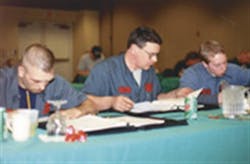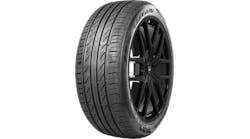How to be fine and not fined: Get to know OSHA before OSHA gets to know you
This article is part of a regular, exclusive series on passenger, light truck and commercial tire service, repair and training produced for Modern Tire Dealer by Kevin Rohlwing, senior vice president of training and technical services for the Tire Industry Association (TIA).
The numbers were staggering. In a 25-year period prior to 1970, more than 400,000 Americans were killed and almost 50 million more suffered disabling injuries.
But the late Congressman William Steiger (R.-Wis.) wasn't referring to casualties and injuries suffered in Korea or Vietnam when he rattled off those figures. He recognized that these growing numbers of occupational deaths and injuries were placing an incredible burden on families and the economy.
At the time, the United States lacked legislation to protect workers. With billions of dollars in lost wages and productivity continuing to grow on an annual basis, something needed to be done.
On Dec. 29, 1970, President Richard M. Nixon signed The Occupational Safety and Health (OSH) Act of 1970. The act, authored by Steiger, changed the American workplace forever.
Companies were forced to protect employees from hazards like asbestos, lead and coal dust. If the occupation required the handling of hazardous materials, then the employers were required by federal law to provide employees with the necessary protective equipment and training. The OSH Act itself created the Occupational Safety and Health Administration (OSHA) within the Department of Labor to establish and enforce standards in the workplace.
Section 18 of the OSH Act encouraged states to establish and enforce their own job safety and health programs. Presently, 26 states have their own OSHA programs, which are approved and monitored by the Federal OSHA.
The OSH Act also gave OSHA the ability to set safety and health standards for specific industries or occupations if the risk to the employee was determined to be severe. OSHA recognizes that standards often result in higher costs to the employer, but the reasoning behind the decisions is based entirely on the risk to the employee.
Additionally, the OSH Act was flexible enough to address general safety-related issues, regardless of the occupation. Also known as "General Duty," the regulation reads like this:
5.(a) Each employer:
(1) shall furnish to each of his employees employment and a place of employment which are free from recognized hazards that are causing or are likely to cause death or serious physical harm to his employees;
(2) shall comply with occupational safety and health standards promulgated under this Act.
In reality, General Duty is OSHA's way of saying, "If we didn't think of it in these regulations, you should have." For example, if large boxes on the top shelf of a storage room fall down and injure an employee, then the company can be cited under General Duty for not protecting workers from falling boxes even though there might not be any specific regulations that govern boxes on shelves.
The employer is required by federal law to provide a hazard-free workplace and failure to do so can, and often does, result in serious fines.
No 'P' or 'LT,' but...
The tire industry can claim one of those occupations deemed hazardous enough to receive a specific regulation. In 1978, OSHA established 29 CFR 1910.177, "Servicing of Single-Piece and Multi-Piece Rim Wheels." This regulation is directed to employees who service tires on large vehicles like trucks, tractors, trailers, buses and off-road machines. However, it excludes employees who service automobile or light truck tires designated "LT."
In other words, if the tire does not have a "P" or "LT" in the tire size and it falls under the categories of truck, tractor, trailer, bus or off-road machine, it's covered by 29 CFR 1910.177.
Contrary to what many believe, there are no OSHA regulations that specifically outline procedures or safety guidelines for servicing passenger and light truck tires. Of course, General Duty still applies, so retail tire dealers must identify and eliminate any potential hazards.
Likewise, all companies must comply with general OSHA regulations for protective equipment, hazardous materials, record keeping, etc.
OSHA and commercial tires
While 29 CFR 1910.177 does not apply to tires labeled "P" or LT," it covers practically every other tire in service today. Trucks, tractors, trailers and buses are fairly simple to recognize, but off-road machines are more difficult to define. The safest bet is to stick to the "P/LT" rule and treat every tire without those letters in the tire size as a candidate for 29 CFR 1910.177.
Without a doubt, the most common violation of 29 CFR 1910.177 is a lack of documented training. OSHA requires every employer to provide a training program that identifies potential hazards for any employees who service tires as defined by 29 CFR 1910.177. For purposes of this article, we'll refer to them as "commercial" tires.
It's important to note that OSHA's definition of "service" includes demounting, mounting, inflating, removing, installing and handling, so any employee who touches an inflated commercial tire for any reason must be trained. Salesmen who deliver mounted and inflated commercial tires must receive training because they are "handling" the assemblies.
Mechanics who remove commercial tires for brake work also must be trained because they are "installing, removing and handling." Truck drivers responsible for inflating their own tires fall under the rule because they are "inflating."
But OSHA takes it several steps further. It's illegal for any employee to service a commercial tire without completing a safety and training program. That means new hires must receive training before they set foot on the shop floor on their first day.
OSHA also specifies the minimum contents of the training and requires each employee to demonstrate his or her ability to perform the tasks necessary for the job. Finally, there must be some form of evaluation to ensure the employee maintains proficiency, and employers must still provide additional training as necessary.
It's relatively safe to say that most commercial tire dealers have employees who are working without documented training. It's even safer to say that most fleets servicing their own tires are in a similar position. The Tire Industry Association (TIA) has an in-house video training program that meets the minimum training requirements established by 29 CFR 1910.177. Companies that take advantage of the Basic Commercial Tire Service (CTS) Program can fulfill their obligation to educate the employees on the hazards related to tire service.
Basic CTS is designed to train new hires and provide documented training for experienced employees. Using a standard video/workbook format, it doesn't require travel or a special instructor. Students that successfully complete the final exam and skills demonstration can receive a TIA Certificate of Completion.
However, complying with the OSHA training requirements doesn't require the actual purchase of anything. TIA has Basic CTS to make it easier, but anyone can get a free copy of 29 CFR 1910.177 and its requirements by visiting OSHA's Web site, www.osha.gov. In an age when government agencies are publicly criticized for wasting money, www.osha.gov represents an excellent investment of taxpayer dollars.
Necessary equipment
Once the training requirements are finally met and out of the way, companies must focus on the necessary equipment for servicing commercial tires under 29 CFR 1910.177. Specifically, every multi-piece assembly must be inflated in a safety cage, so any service area where multi-piece wheels are inflated must have one.
Since OSHA's definition of "service area" includes road service vehicles, each truck also must have a safety cage.
The safety cage itself must be capable of withstanding 150% of the maximum force transferred to it during a rim separation or explosion. Reputable safety cage manufacturers have the engineering data to document compliance, but your local welding shop will probably have to rely on a field test.
OSHA also has specific requirements for all tire inflation devices. First, there must be a clip-on chuck. A clip-on chuck is any air chuck that temporarily attaches itself to the end of the valve stem without being screwed or held on. Lock-on dual foot chucks without an actual "clip" are considered to be clip-on air chucks simply because they are not screwed on and do not require a technician to hold it on the end of the stem.
Inflation devices also must include an in-line valve with a pressure gauge or a pre-setable regulator. Theoretically, this prevents technicians from accidentally over-inflating a tire. Either the technician has to literally fall asleep while holding down the button or the regulator must be set above the maximum inflation pressure for the tire being inflated. Regardless, one or the other must be used.
The final tire inflation device requirement is defined as a "sufficient length of hose" to allow the employee to stand outside the trajectory of the tire sidewalls during the inflation process. California has the only OSHA regulation that provides a minimum number of feet (2 feet), so the rest of the country is required to determine the actual length of "sufficient" on its own.
Rim regs
Throughout the remainder of 29 CFR 1910.177, OSHA outlines procedures for matching rim components and demounting/mounting/inflating single- and multi-piece assemblies. If any of the practices are not followed and an accident results, OSHA will assess fines based on the number of violations. Keep in mind that failure to train 10 employees can represent 10 individual violations and, therefore, 10 fines.
Even though the tire-specific OSHA regulation excludes passenger and light truck tires, there are still laws in place to protect the employees. As stated earlier, General Duty applies to every workplace and any potential hazard.
However, when it comes to "Personal Protective Equipment" (PPE), OSHA goes several steps further in explaining when it's necessary and what is necessary.
* 29 CFR 1910.120 covers employees who handle hazardous materials. "Work functions that preclude splashes, immersion or the potential for unexpected inhalation of or contact with hazardous levels of any chemicals" require Level D protection. Level D protection includes coveralls, gloves, steel toe and shank boots and safety glasses.
* 29 CFR 1910.132 requires training for employees who must use PPE. The training must include when PPE is necessary, what PPE is necessary, the limitations of PPE, the proper care/maintenance/life span/disposal of PPE, and, finally, how to "properly don, doff, adjust and wear PPE."
* 29 CFR 1910.133 requires safety glasses for any employee that is exposed to any hazards due to flying objects.
* 29 CFR 1910.136 outlines the requirements for occupational foot protection.
* 29 CFR 1910.138 identifies the situations where hand protection is necessary.
It's difficult to imagine any tire dealers who don't fall under the OSHA regulations for PPE. OSHA has similar guidelines for fire safety, hazardous materials handling/disposal, and a number of other common practices inside a typical tire service facility.
It also offers a free consultation service that will identify every OSHA violation without any fines as long as the problems are corrected. It might seem ludicrous to invite an OSHA inspector to look for safety and training program deficiencies in your shop, but the cost of finding out the hard way can devastate any size company.
Just last month, three large companies were fined a total of $730,000 for violations ranging from missing safety guards to holes in the floor. It's important to note that none of the fines were the direct result of an on-the-job accident or injury. In one instance, an employee complaint resulted in the inspection while the others were random inspections.
OSHA often bases the size of the fine on the size of the company. A construction worker was killed recently when a road-tar kettle exploded, but that company only was fined $7,500 because it only had three workers.
Bottom line
OSHA's mission is to provide a safe workplace for American workers. Since 1970, the number of workers has nearly doubled to more than 105 million private sector employees at 6.9 million sites. Yet in that period of time, on-the-job accidents have been drastically cut, resulting in fewer injuries or deaths.
As the workplace continues to evolve, OSHA will react with newer standards and educational programs to ensure an American worker's right to a safe environment. Once referred to as the "safety bill of rights," OSHA standards are designed to protect employees from hazards, regardless of the cost to the employers.
Ultimately, if companies take the time to get to know OSHA and follow the laws, then OSHA will never have to get to know them.
(In photo: The Tire Industry Association offers Commercial Tire Service (CTS) programs designed to educate your employees on the hazards related to tire service. Pictured at a regional CTS seminar held earlier this year are, from left to right: Brian Hockenberry, Doug Cross and Kyle Martin from McMahon Tire in Fort Wayne, Ind.)




